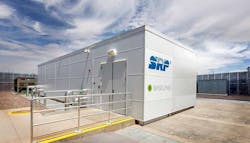PHOENIX, Ariz. – At first glance, the modular data center being developed by the Salt River Project (SRP) doesn’t seem unusually futuristic. There’s no virtual reality or flying cars involved. But the prototype, known as a DataStation, represents an ambitious vision of the future of the data center industry.
“This is a monumental effort to change the way the industry does things,” said Clint Poole, manager of SRP Telecom. “We’ve taken the data center operation apart and put it back together.”
The project is guided by a simple idea: What if we build data centers at the power grid, instead of extending power infrastructure to a distant data center. Poole believes it’s an approach that combines exceptional reliability and leaner, cheaper infrastructure.
The DataStation prototype is most notable for the items you don’t see. It has no generators or UPS systems, which are unnecessary due to the reliability of these intersections of transmission lines, enabling a “grid-on-grid” backup architecture.
A Key Intersection on the Power Grid
The DataStation concept, which we first reported on during its development phase in 2015, connects the data center to the bulk transmission lines and substations that serve as the fast lane of the power grid. The modular data center resides on a secure site next to a high-capacity 230kV power line.
SRP is working with BASELAYER, a Phoenix-area company that specializes in pre-fabricated, factory-built data centers. With the DataStation project, the two companies hope to shift hyperscale cloud farms closer to the heart of the power grid, an architecture that promises major benefits for both industries.
It’s one of a number of efforts to rethink the relationship between data center facilities and their supporting infrastructure. While SRP focuses on placing data modules near the power grid, companies like Vapor IO hope to enable networks of modular data centers at the base of wireless towers.
SRP Testing Its Reliability Projections
SRP believes that moving closer to power sources will make it easier for data centers to provision large amounts of electricity, and to gradually expand their capacity over time. The bulk transmission system also offers improved reliability, which could allow cloud builders to operate without expensive backup equipment.
Eliminating expensive generators and UPS systems has been a goal for some hyperscale providers. In 2010, Yahoo began exploring using power backup for only a portion of its workloads, primarily for networking. Facebook chose Lulea, Sweden for a data center because the robust local power grid allowed it to operate with fewer generators.
Over the past 18 months, data center service providers have begin offering variable resiliency space that runs with little or no UPS and generator support. Vantage Data Centers and Verne Global have been among the providers embracing this trend.
The DataStation can offer similar savings, only with high reliability. To validate their assumptions, SRP and BASELAYER are working with several teams to assess the reliability of the DataStation prototype. These include the Department of Energy’s Oak Ridge Laboratory, and MTechnology, an engineering firm specializing in reliability in mission-critical facilities.
“We want to leverage this site to bring additional validation points,” said Poole. “We’re looking for a web scale pilot.”
Business Opportunity for Utilities
Poole says the DataStation could create a new business model for the electric utility industry to work with data center providers. Moving hyperscale cloud farms closer to the heart of the power grid, he says, promises major benefits for both industries.
Another customer profile is the military. The idea has made it onto the radar screen of the Air Force, which is exploring options for consolidating its infrastructure.
“I visited SRP and BASELAYER’s DataStation (modular data center technology located physically on the power grid) a few months ago,” said Lt. General William Bender. Chief Information Officer of the U.S. Air Force. “As we work hard to consolidate and optimize our data center infrastructure, the Air Force is evaluating whether DataStation is a viable approach within our enterprise portfolio. Without a doubt, I see this approach as an excellent example of the type of innovation the Air Force needs, as well as the kind of public/private partnership required to modernize and better secure the Department of Defense’s data center infrastructure.”
Bender said the DatStation concept aligned with ” the Air Force’s focus on mission assurance, cyber security, lowering enterprise data center costs and commitment to leveraging renewable energy sources like solar to the maximum extent possible.”
Salt River Project (SRP) provides electricity to more than 1 million retail power customers in a 2,900 square mile territory spanning the Phoenix market. It’s an integrated utility, meaning that it serves the entire supply chain, including power generation, transmission, distribution, and metering and billing.
Fiber Play As Well As Power Play
The DataStation prototype is located in a Phoenix suburb at a key junction point on the SRP grid, where the 230kV lines “step down” to 69kV lines that distribute power out to the community, with further step-downs between the business and residential end users. Two 69kV lines feed theSRP site.
For SRP, the DataStation is not just about power. Above the three conductors on each tower runs a ground static wire, along with a fiber optic cable bringing network connectivity to customers. Poole is manager of the SRP Telecom business, and has developed the vision for a “grid-integrated” data center.[clickToTweet tweet=”Clint Poole of SRP: We’ve taken the data center operation apart and put it back together.” quote=”Clint Poole of SRP: We’ve taken the data center operation apart and put it back together.”]
Poole believes the concept presents compelling economics for companies that want to support their data center with two segregated power feeds. It’s much cheaper to create the data center where the grids meet, compared to the investment of extending the power to another location.
Expand As You Go
What does a grid-integrated data center look like? One of the first things you notice about the site is the security, which includes fences, multiple motion detectors, video cameras and infrared sensors.
The prototype site supports 2 megawatts of capacity in a 1N configuration, or 1 megawatt in a redundant 2N facility. Additional modules can be added as needed, enabling customers to expand as needed, either building in bunches or pursuing a gradual deployment that allows for incremental investments of capital.
The interior of the DataStation created by SRP Telecom and BASELAYER features cabinets with 52U of capacity. (Photo: SRP)
“You can build what you need, when you need it,” said Poole, who said the BASELAYER modules allow SRP to take the compute to where the power, rather than vice versa.
This “data center anywhere” concept has been the driving vision behind BASELAYER, which was born in the research and development labs at IO and has since spun out into a stand-alone company.
Samir Shah, the Chief of Staff at BASELAYER, said SRP understands how factory-built capacity can disrupt where data centers are deployed. That may provide a new model for deployment as the geography of the network evolves to support low-latency, high-bandwidth applications such as the Internet of Things, edge computing, virtual reality and autonomous cars.
Modules Enabling A Vision
“SRP really looked at the apps that drive the need,” said Shah. “With content distribution being what it is, you use the hub for storage and end points for access for customers.”
The end of each module serves as a dock, an attachment point for plumbing and 250kW of power, with two entrances for the separate feeds. There’s a vestibule and entrance area where a security station can be deployed for multi-tenant deployments.
The BASELAYER Edge module has fully separated hot and cold aisles, with up to eight fans supporting the cooling system. Extra-tall rocks can support up to 52u of servers and storage equipment. The unit runs at 1.2 PUE during commissioning with load banks.
Poole said SRP is assessing four locations on its grid for future use as data station sites. The concept could work for other utilities as well, creating a way for utilities to build revenue by hosing modular data stations on the real estate supporting their transmission systems.
‘More Than A Science Fair Project’
“We want to look at how this scales,” he added. “If we can do it, others can do it. That’s our vision.”
“We’re trying to forklift change into two industries (telecom and power),” said Poole. “You’re losing the requirement for a lot of infrastructure. If you remove all the things that are prone to failure, your reliability should go up.”[clickToTweet tweet=”SRP’s Clint Poole: We’re trying to forklift change into two industries (telecom and power).” quote=”SRP’s Clint Poole: We’re trying to forklift change into two industries (telecom and power).”]
New ideas take time and validation to gain traction in the data center. Poole expects the assessments of the DataStation concept will provide a compelling argument for a new deployment model in an evolving technology landscape.
“This is more than a science fair project for us,” said Poole. “We believe this is the way data centers will be deployed. This approach will play a critical role going forward.”






